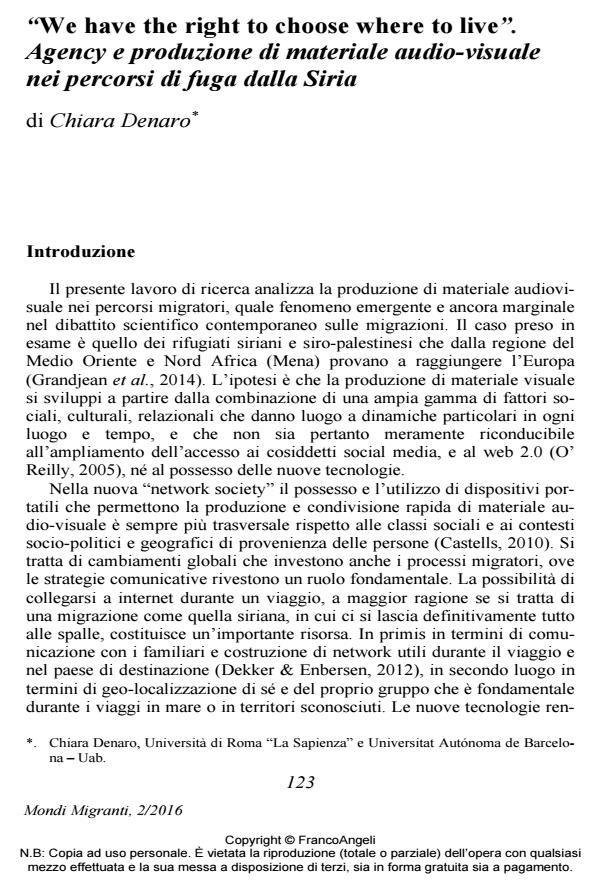"We have the right to choose where to live". Agency e produzione di materiale audio-visuale nei percorsi di fuga dalla Siria
Titolo Rivista MONDI MIGRANTI
Autori/Curatori Chiara Denaro
Anno di pubblicazione 2016 Fascicolo 2016/2
Lingua Inglese Numero pagine 23 P. 123-145 Dimensione file 349 KB
DOI 10.3280/MM2016-002007
Il DOI è il codice a barre della proprietà intellettuale: per saperne di più
clicca qui
Qui sotto puoi vedere in anteprima la prima pagina di questo articolo.
Se questo articolo ti interessa, lo puoi acquistare (e scaricare in formato pdf) seguendo le facili indicazioni per acquistare il download credit. Acquista Download Credits per scaricare questo Articolo in formato PDF

FrancoAngeli è membro della Publishers International Linking Association, Inc (PILA)associazione indipendente e non profit per facilitare (attraverso i servizi tecnologici implementati da CrossRef.org) l’accesso degli studiosi ai contenuti digitali nelle pubblicazioni professionali e scientifiche
In the frame of a wider exploration of the migratory paths of Syrian refugees towards Europe, which has been realised through an ethnographic approach, it has been possible to collect photographic and audiovisual material, mainly produced by refugees during their travel. Although at times this material seems to have been produced with the aim of documenting their travels thanks to the increasingly diffuse endowment of technologies which allow that practice at other times it seems to have a broader meaning. In some cases it is configured as a visual support to the launches of SOS from the sea and to requests for assistance; in other cases it is a tool of witness, concerning the denunciation of violence suffered in border spaces. In attempting to grasp its multiple meanings, the relational environment/context in which each image is placed has a fundamental importance. It is characterised by a multiplicity of institutional and non-institutional actors, which if on the one hand play a still ill-defined role in the (co)production of the audiovisual material, on the other, after its reception, (re)act in an innovative way. The article addresses particular contexts of the production of images by Syrian refugees, such as detention spaces in transit countries, journeys by sea, and first reception spaces. The analysis of audiovisual material will be led by three research questions. Firstly, how did the practice of self-documentation beging? And, what was its aim? Secondly, what is the relational environment of the production of audiovisual material by migrants? And how are these relationships eventually able to direct its content? Thirdly, is it possible to interpret this audiovisual production as a means of self-determination, empowerment and resistance?
Nell’ambito dell’esplorazione dei percorsi migratori intrapresi dai rifugiati siriani verso l’Europa, realizzata mediante un approccio etnografico, è stato possibile collezionare materiale fotografico e audio-visuale, per lo più realizzato dai migranti stessi durante il viaggio. Tale materiale, se in alcuni casi sembra esser stato prodotto al semplice scopo di documentare i viaggi, grazie alla dotazione sempre più diffusa di strumenti tecnologici che lo permettono, dall’altro sembra avere un significato più ampio. In alcuni casi, esso si configura come "supporto visuale" a richieste attive di salvataggio in mare e di aiuto; in altri costituisce testimonianza, nell’ambito di denunce in merito a violenze subite nei luoghi di frontiera. Al fine di coglierne i molteplici significati, importanza fondamentale riveste il contesto relazionale in cui ciascuna immagine si va a collocare. Esso è caratterizzato da una molteplicità di attori, istituzionali e non che, se per un verso ricoprono un ruolo ancora poco definito nella produzione di materiale-audiovisuale per l’altro, in seguito alla sua ricezione, (re)agiscono in maniera innovativa. L’articolo prende in considerazione alcuni particolari contesti di produzione di immagini da parte dei richiedenti asilo siriani, quali luoghi di detenzione nei paesi di transito, viaggi via mare, operazioni di salvataggio e di monitoraggio delle stesse; luoghi di prima accoglienza. L’analisi del materiale audio-visuale sarà dunque guidata da tre domande di ricerca. 1) Come nasce questa pratica di auto-documentazione? E con quale finalità? 2) Che tipo di relazioni fanno da contesto alla produzione di tale documentazione? Ed eventualmente, come queste relazioni sono in grado di orientarne il contenuto? 3) è possibile ricondurre tale produzione visuale a percorsi di auto-determinazione, empowerment e resistenza?
Parole chiave:Rifugiati; Siria; visuale; agency; empowerment; resistenza.
Chiara Denaro, "We have the right to choose where to live". Agency e produzione di materiale audio-visuale nei percorsi di fuga dalla Siria in "MONDI MIGRANTI" 2/2016, pp 123-145, DOI: 10.3280/MM2016-002007